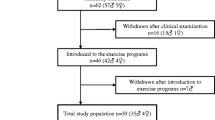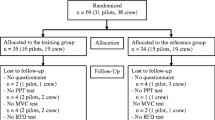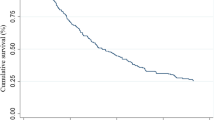Abstract
Changes in the physical capacity, musculoskeletal symptoms, and perceived work ability of Finnish Air Force maintenance personnel were studied after vocationally oriented medical rehabilitation (VOMR® ). Twenty persons with chronic musculoskeletal symptoms in their back or neck took part in VOMR® courses. The measurements were carried out at the beginning of the rehabilitation course and after two follow-up periods (0.5 and 5 years). The subjects worked most of the time in a bent position and often with their backs twisted and their arms above their shoulders. The severity of low-back pain and the number of days of sick leave decreased significantly (p < 0.05–0.01) during the 5-years follow-up. Also the exercise breaks at work increased (p < 0.01). After half a year of medical rehabilitation the measured range of the cervical spine and the dynamic and endurance strength of the upper and lower extremities was greater (p < 0.05–0.001) than at the beginning of the rehabilitation. There were no statistically significant differences in the use of physical therapy, experienced work strain, physical exercise or maximal oxygen consumption during the follow-up. This is a preliminary follow-up study lasting 5 years showed some significant changes in physical capacity, musculoskeletal symptoms and work ability. However, controlled studies are needed to evaluate these preliminary findings of this kind of rehabilitation model.
Similar content being viewed by others
REFERENCES
Lind J. The need for early rehabilitation and its effectiveness in industry. A study concerning the possibilities of early rehabilitation in three industrial firms in South-West Finland. Publications of the Social Insurance Institution ML, 67. Turku (Finland): Social Insurance Institution, 1987.
Alaranta H, Rytökoski U, Rissanen A, Talo S, Rönnemaa T, Karppi S-L, Puukka P, Lind J, Rissanen P, Videman T, Slätis P, Kallio V. Progressive work hardening program for patients with low back pain: A controlled clinical trial. Publications of the Social Insurance Institution ML: 103. Turku (Finland): Social Insurance Institution, 1991.
Saloheimo E, Klaukka T, Sievers K. Controlled clinical trials on physical medicine. Publications of the Social Insurance Institution AL, 30. Helsinki: Social Insurance Institution, 1986.
Leino P, Kivekäs J, Hänninen K. Effects of work-oriented fitness courses in lumberjacks with low back pain. J Occup Rehabil1994; 4: 67-76.
Nevala-Puranen N. Effects of occupationally-oriented rehabilitation on farmers work techniques, muscu-loskeletal symptoms, and work ability. J Occup Rehabil1996; 6: 191-200.
Smolander J, Louhevaara V, Ilmarinen J, Korhonen, O. Effects of a worksite exercise promotion program on the physical fitness and work ability of older metal workers. Ty ö ja ihminen1994; 8: 163-170.
Järvinen P, Järvisalo J, Parviainen A, Pietikåinen I, Puukka P, Varjo J. Effect of vocational rehabilitation measured as absenteeism. Suomen Lääkäril1995; 50: 585-590.
Arokoski JPA, Nevala-Puranen N, Danner R, Halonen M, Tikkanen R. Occupationally oriented medical rehabilitation and hairdressers work techniques-A one-and-a half year follow-up. Int J Occup Safety Ergon1998; 4: 43-56.
Nevala-Puranen N. Reduction of farmers' postural load during occupationally oriented medical rehabilitation. Appl Ergon1995; 26: 411-415.
Nevala-Puranen N, Halonen M, Tikkanen R. Arokoski J. Changes in hairdressers' work techniques and physical capacity during rehabilitation. Occup Ergon1998; 1: 259-268.
Väyrynen S, Könönen U. Short and long-term effects of a training programme on work postures in rehablitees: A pilot study of loggers suffering from back troubles. Int J Ind Ergon1991; 7: 103-109.
Arokoski JPA, Juntunen M, Luikku J. Musculoskeletal symptoms, physical performance, leisure-time physical activity and use of health-care services after occupationally oriented medical rehabilitation-A one and a half year follow-up with farmers, loggers, police officers and hairdressers. Int J Rehabil Res2002; 25: 119-131.
Arokoski JPA, Holopainen K, Koistinen S, Kuronen P. Effects of the neck course on fighter pilots neck-shoulder symptoms and physical capacity-Finnish Air Force fighter pilots one-year follow-up study. Ann Med Milit Fenn1996; 71: 7-12.
Price D, McGrath PA, Rafii A, Buckinham B. The validation of visual analogue scale as ratio scale measure for chronic and experimental pain. Pain1983; 17: 45-46.
American College of Sports Medicine (ACSM). Guidelines for exercise testing and prescription, 5th ed. Philadelphia: Lea & Febiger, 1995.
Alaranta H, Hurri H, Heliövaara M, Soukka A, Harju R, Non-dynamometric trunk performance tests: Relia-bility and normative data. Scand J Rehab Med1994; 26: 211-215.
Youdas J, Carey J, Garret T. Reliability of measurement cervical spine range of motion-Comparison of three methods. Phys Ther1991; 2: 98-106.
Penttinen J, Nevala-Puranen N, Airaksinen O, Heikkinen P, Jääskeläinen M, Sintonen H, Takala J. Randomized controlled trial of back school with and without peer support. J Occup Rehabil2002; 12: 21-29.
Kilbom å, Persson J, Jonsson BG. Disorders of the cervicobrachial region among female workers in the electronic industry. Int J Ind Ergon1986; 1: 37-47.
Linton SJ, Bradley LA, Jensen I, Spangfort E, Sundell L The secondary prevention of low back pain: A controlled study with follow-up. Pain1989; 36: 197-207.
Donchin M, O. Woolf, L. Kaplan, Y. Floman. Secondary prevention of low-back pain. A clinical trial. Spine1990; 15: 1317-1320.
Lindstrom I, Ohlund C, Eek C, Wallin L, Peterson LE, Fordyce WE, Nachemson AL. The effect of graded activity on patients with subacute low back pain: A randomized prospective clinical study with an operant-conditioning behavioral approach. Physical Therapy1992; 72: 279-290.
Lindh M, Lurie M, Sanne H. A randomized prospective study of vocational outcome in rehabilitation of patients with non-specific musculoskeletal pain: A multidisciplinary approach to patients identified after 90 days of sick-leave. Scand J Rehabil1997; 29: 103-112.
Author information
Authors and Affiliations
Rights and permissions
About this article
Cite this article
Holopainen, K., Nevala, N., Kuronen, P. et al. Effects of Vocationally Oriented Medical Rehabilitation for Aircraft Maintenance Personnel—A Preliminary Study of Long-Term Effects with 5-year Follow-Up. J Occup Rehabil 14, 233–242 (2004). https://doi.org/10.1023/B:JOOR.0000047426.84072.18
Issue Date:
DOI: https://doi.org/10.1023/B:JOOR.0000047426.84072.18




